Implementing Flexible Working Hours for Improved Work-Life Balance
VerifiedAdded on 2022/09/06
|12
|2281
|17
Report
AI Summary
This report examines the concept of flexible working hours and their positive impact on employee work-life balance and organizational success. The report begins with an executive summary highlighting the benefits for both employees and employers, emphasizing the positive influence on employee well-being and organizational performance. The discussion section explores the increasing significance of flexible working conditions in the modern economy, supported by examples from Scandinavia and the UK. It delves into the benefits for employees, such as improved work-life balance, reduced stress, and better health, as well as organizational advantages, including increased productivity, employee retention, and the ability to attract a diverse workforce. The report also addresses the importance of employee control, physical and mental health improvements, and the reduction of tiredness. The conclusion summarizes the key findings and recommends the implementation of flexible work timings to achieve both employee and organizational benefits. References to relevant studies and literature are also included.
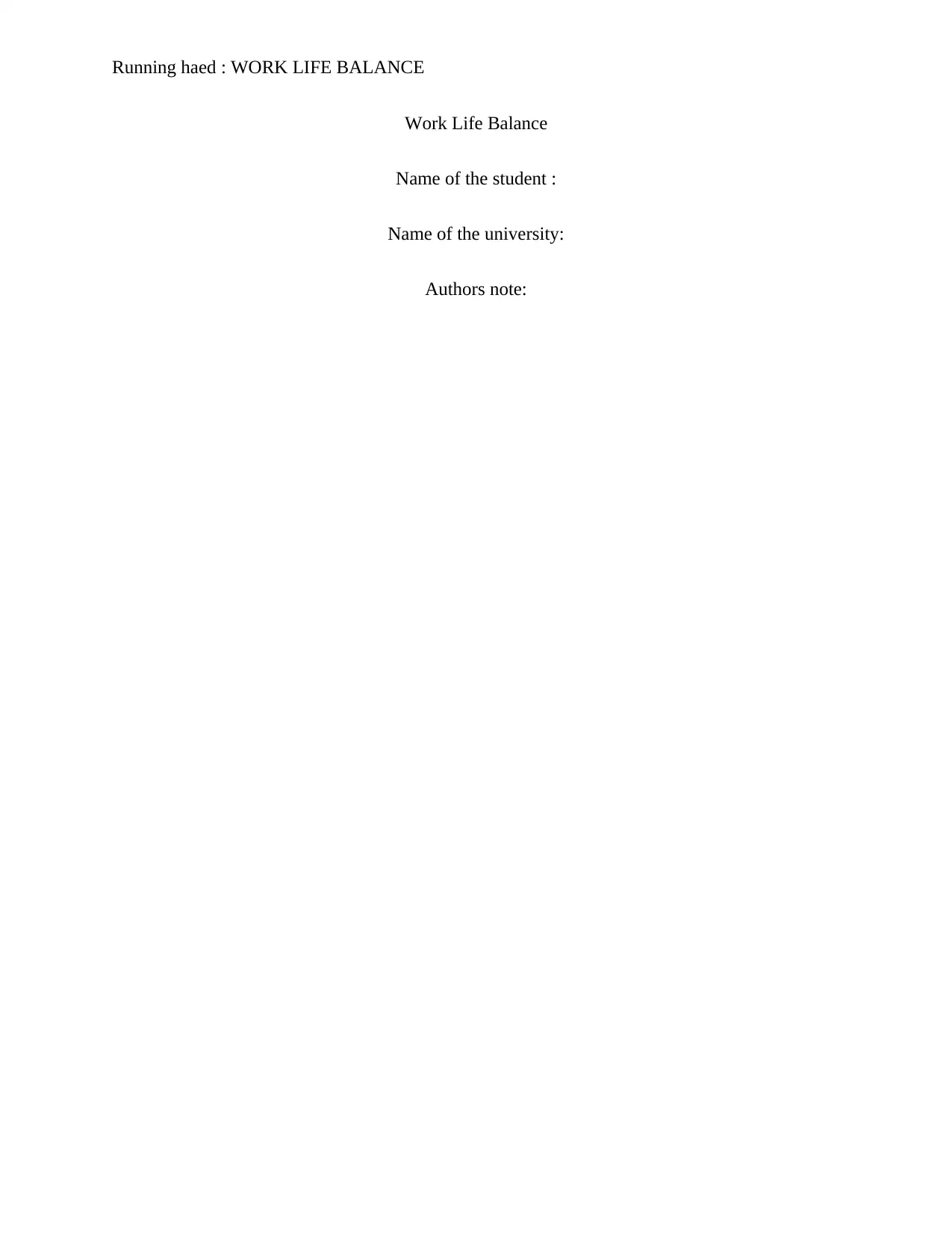
Running haed : WORK LIFE BALANCE
Work Life Balance
Name of the student :
Name of the university:
Authors note:
Work Life Balance
Name of the student :
Name of the university:
Authors note:
Paraphrase This Document
Need a fresh take? Get an instant paraphrase of this document with our AI Paraphraser
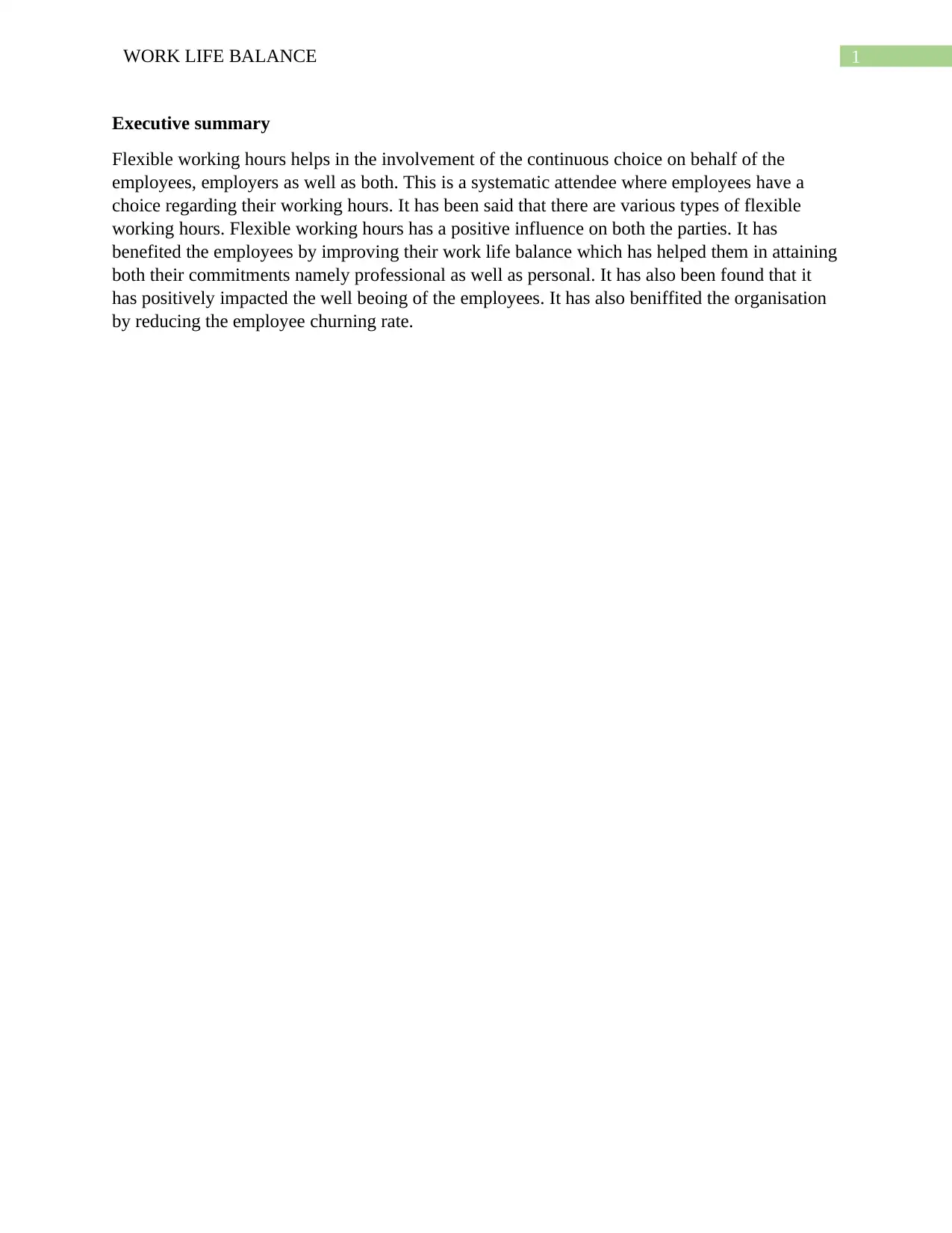
1WORK LIFE BALANCE
Executive summary
Flexible working hours helps in the involvement of the continuous choice on behalf of the
employees, employers as well as both. This is a systematic attendee where employees have a
choice regarding their working hours. It has been said that there are various types of flexible
working hours. Flexible working hours has a positive influence on both the parties. It has
benefited the employees by improving their work life balance which has helped them in attaining
both their commitments namely professional as well as personal. It has also been found that it
has positively impacted the well beoing of the employees. It has also beniffited the organisation
by reducing the employee churning rate.
Executive summary
Flexible working hours helps in the involvement of the continuous choice on behalf of the
employees, employers as well as both. This is a systematic attendee where employees have a
choice regarding their working hours. It has been said that there are various types of flexible
working hours. Flexible working hours has a positive influence on both the parties. It has
benefited the employees by improving their work life balance which has helped them in attaining
both their commitments namely professional as well as personal. It has also been found that it
has positively impacted the well beoing of the employees. It has also beniffited the organisation
by reducing the employee churning rate.
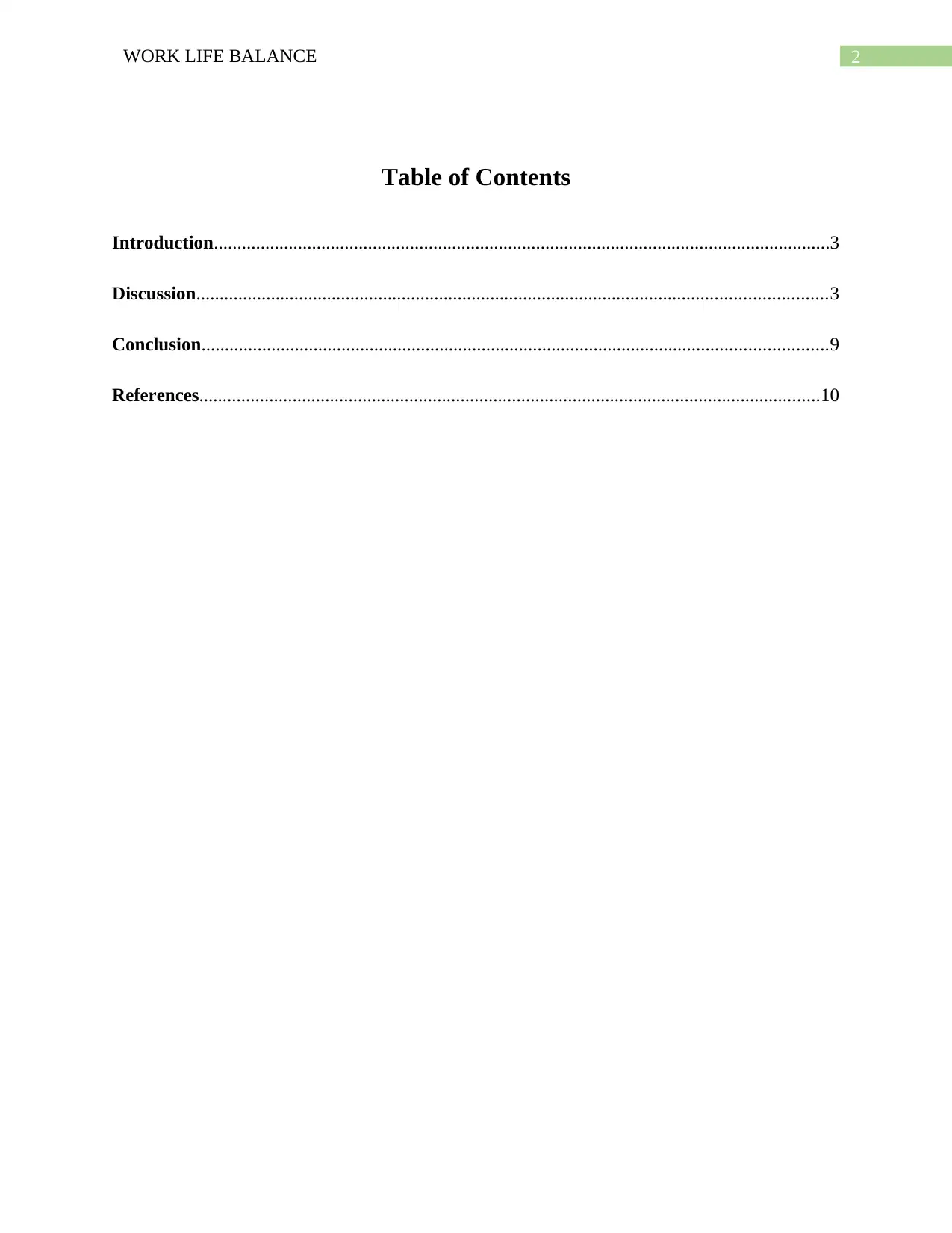
2WORK LIFE BALANCE
Table of Contents
Introduction....................................................................................................................................3
Discussion.......................................................................................................................................3
Conclusion......................................................................................................................................9
References.....................................................................................................................................10
Table of Contents
Introduction....................................................................................................................................3
Discussion.......................................................................................................................................3
Conclusion......................................................................................................................................9
References.....................................................................................................................................10
⊘ This is a preview!⊘
Do you want full access?
Subscribe today to unlock all pages.

Trusted by 1+ million students worldwide
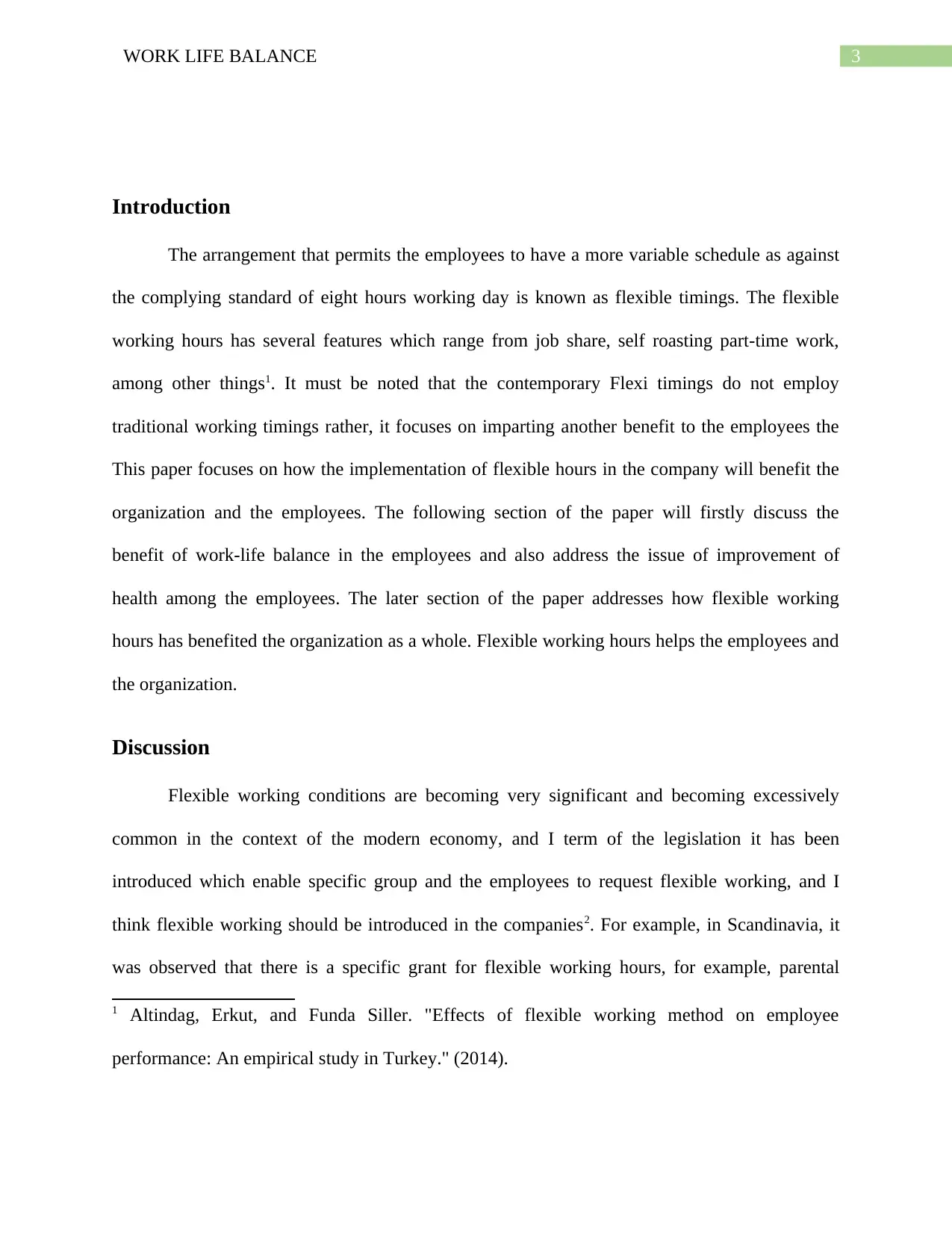
3WORK LIFE BALANCE
Introduction
The arrangement that permits the employees to have a more variable schedule as against
the complying standard of eight hours working day is known as flexible timings. The flexible
working hours has several features which range from job share, self roasting part-time work,
among other things1. It must be noted that the contemporary Flexi timings do not employ
traditional working timings rather, it focuses on imparting another benefit to the employees the
This paper focuses on how the implementation of flexible hours in the company will benefit the
organization and the employees. The following section of the paper will firstly discuss the
benefit of work-life balance in the employees and also address the issue of improvement of
health among the employees. The later section of the paper addresses how flexible working
hours has benefited the organization as a whole. Flexible working hours helps the employees and
the organization.
Discussion
Flexible working conditions are becoming very significant and becoming excessively
common in the context of the modern economy, and I term of the legislation it has been
introduced which enable specific group and the employees to request flexible working, and I
think flexible working should be introduced in the companies2. For example, in Scandinavia, it
was observed that there is a specific grant for flexible working hours, for example, parental
1 Altindag, Erkut, and Funda Siller. "Effects of flexible working method on employee
performance: An empirical study in Turkey." (2014).
Introduction
The arrangement that permits the employees to have a more variable schedule as against
the complying standard of eight hours working day is known as flexible timings. The flexible
working hours has several features which range from job share, self roasting part-time work,
among other things1. It must be noted that the contemporary Flexi timings do not employ
traditional working timings rather, it focuses on imparting another benefit to the employees the
This paper focuses on how the implementation of flexible hours in the company will benefit the
organization and the employees. The following section of the paper will firstly discuss the
benefit of work-life balance in the employees and also address the issue of improvement of
health among the employees. The later section of the paper addresses how flexible working
hours has benefited the organization as a whole. Flexible working hours helps the employees and
the organization.
Discussion
Flexible working conditions are becoming very significant and becoming excessively
common in the context of the modern economy, and I term of the legislation it has been
introduced which enable specific group and the employees to request flexible working, and I
think flexible working should be introduced in the companies2. For example, in Scandinavia, it
was observed that there is a specific grant for flexible working hours, for example, parental
1 Altindag, Erkut, and Funda Siller. "Effects of flexible working method on employee
performance: An empirical study in Turkey." (2014).
Paraphrase This Document
Need a fresh take? Get an instant paraphrase of this document with our AI Paraphraser
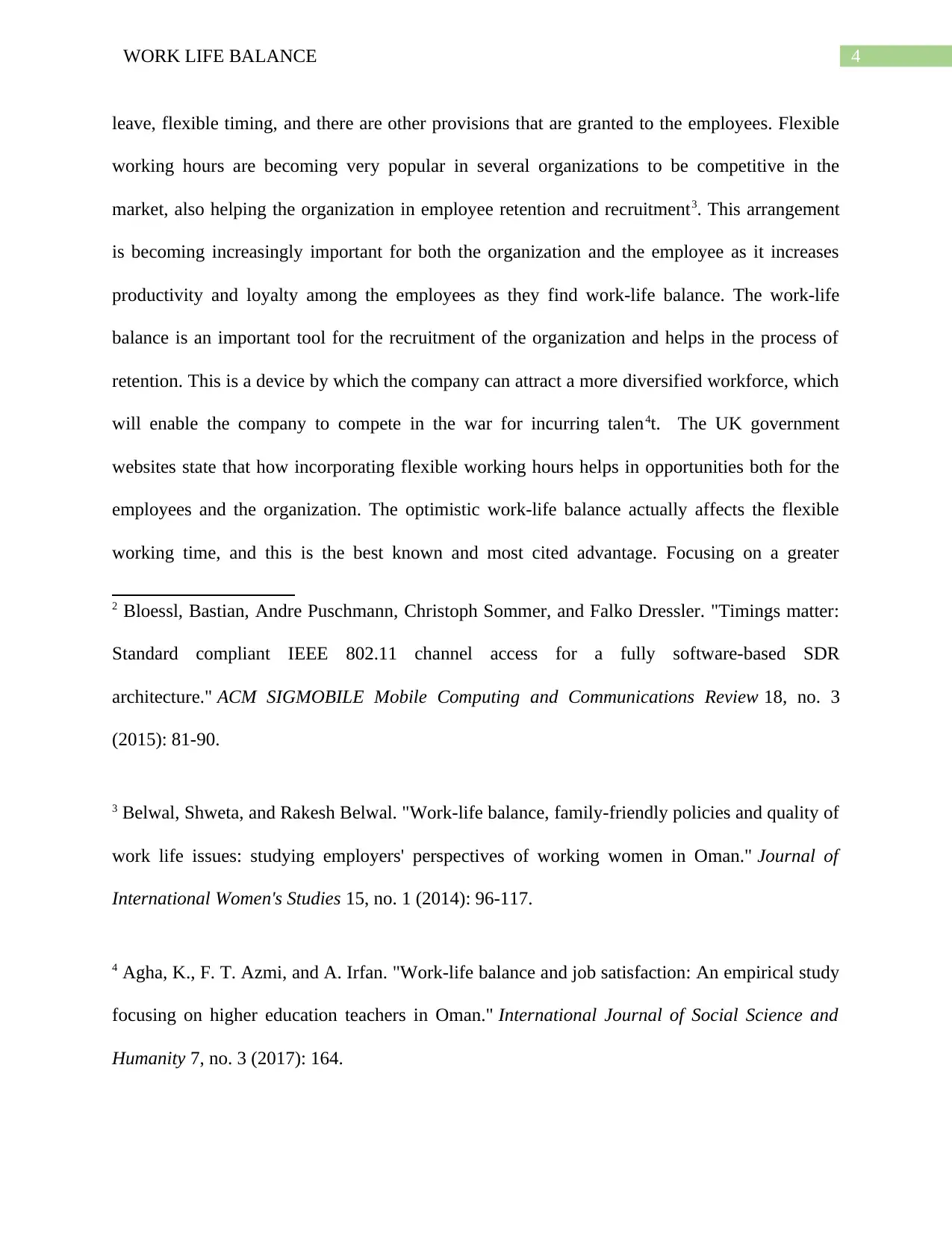
4WORK LIFE BALANCE
leave, flexible timing, and there are other provisions that are granted to the employees. Flexible
working hours are becoming very popular in several organizations to be competitive in the
market, also helping the organization in employee retention and recruitment3. This arrangement
is becoming increasingly important for both the organization and the employee as it increases
productivity and loyalty among the employees as they find work-life balance. The work-life
balance is an important tool for the recruitment of the organization and helps in the process of
retention. This is a device by which the company can attract a more diversified workforce, which
will enable the company to compete in the war for incurring talen4t. The UK government
websites state that how incorporating flexible working hours helps in opportunities both for the
employees and the organization. The optimistic work-life balance actually affects the flexible
working time, and this is the best known and most cited advantage. Focusing on a greater
2 Bloessl, Bastian, Andre Puschmann, Christoph Sommer, and Falko Dressler. "Timings matter:
Standard compliant IEEE 802.11 channel access for a fully software-based SDR
architecture." ACM SIGMOBILE Mobile Computing and Communications Review 18, no. 3
(2015): 81-90.
3 Belwal, Shweta, and Rakesh Belwal. "Work-life balance, family-friendly policies and quality of
work life issues: studying employers' perspectives of working women in Oman." Journal of
International Women's Studies 15, no. 1 (2014): 96-117.
4 Agha, K., F. T. Azmi, and A. Irfan. "Work-life balance and job satisfaction: An empirical study
focusing on higher education teachers in Oman." International Journal of Social Science and
Humanity 7, no. 3 (2017): 164.
leave, flexible timing, and there are other provisions that are granted to the employees. Flexible
working hours are becoming very popular in several organizations to be competitive in the
market, also helping the organization in employee retention and recruitment3. This arrangement
is becoming increasingly important for both the organization and the employee as it increases
productivity and loyalty among the employees as they find work-life balance. The work-life
balance is an important tool for the recruitment of the organization and helps in the process of
retention. This is a device by which the company can attract a more diversified workforce, which
will enable the company to compete in the war for incurring talen4t. The UK government
websites state that how incorporating flexible working hours helps in opportunities both for the
employees and the organization. The optimistic work-life balance actually affects the flexible
working time, and this is the best known and most cited advantage. Focusing on a greater
2 Bloessl, Bastian, Andre Puschmann, Christoph Sommer, and Falko Dressler. "Timings matter:
Standard compliant IEEE 802.11 channel access for a fully software-based SDR
architecture." ACM SIGMOBILE Mobile Computing and Communications Review 18, no. 3
(2015): 81-90.
3 Belwal, Shweta, and Rakesh Belwal. "Work-life balance, family-friendly policies and quality of
work life issues: studying employers' perspectives of working women in Oman." Journal of
International Women's Studies 15, no. 1 (2014): 96-117.
4 Agha, K., F. T. Azmi, and A. Irfan. "Work-life balance and job satisfaction: An empirical study
focusing on higher education teachers in Oman." International Journal of Social Science and
Humanity 7, no. 3 (2017): 164.
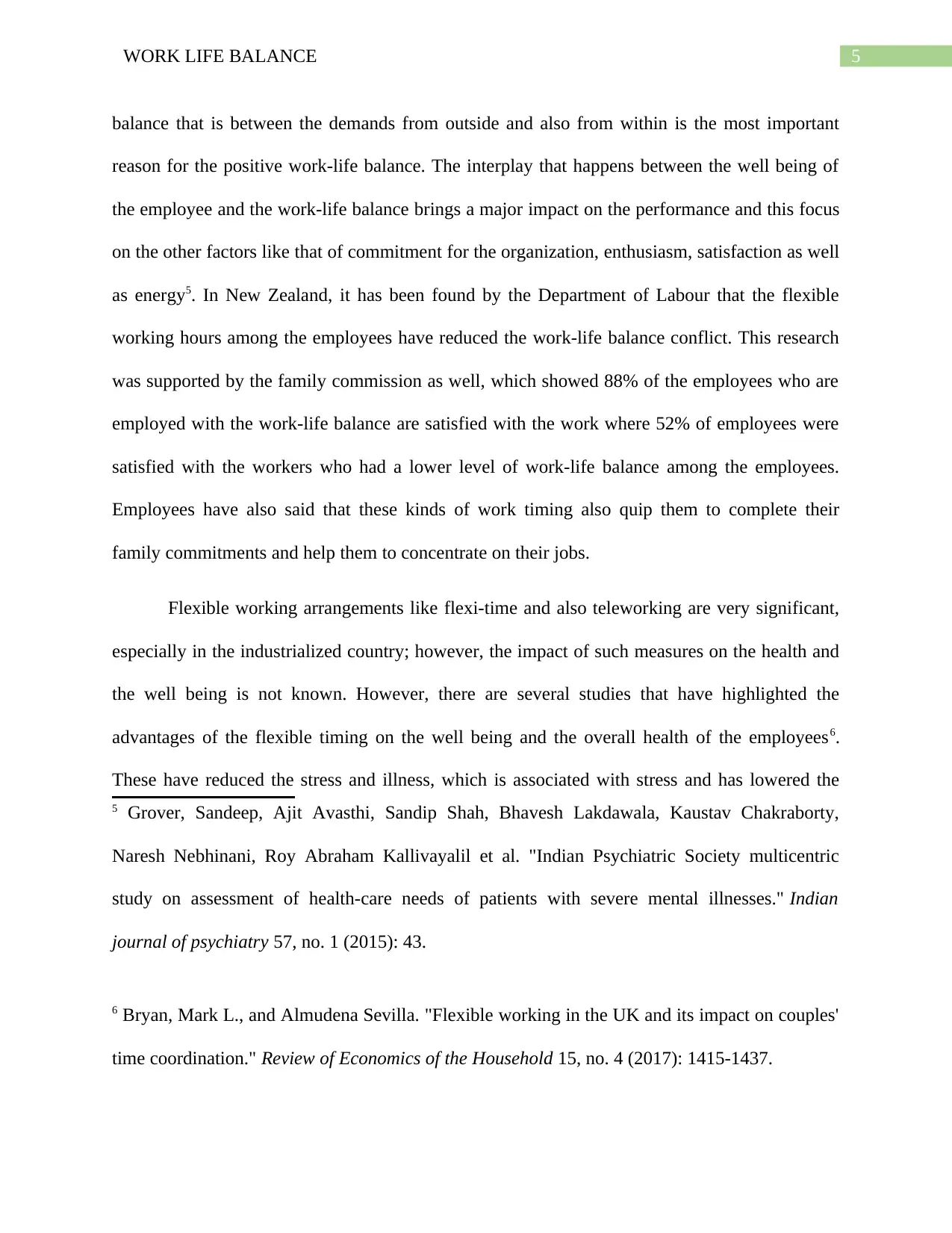
5WORK LIFE BALANCE
balance that is between the demands from outside and also from within is the most important
reason for the positive work-life balance. The interplay that happens between the well being of
the employee and the work-life balance brings a major impact on the performance and this focus
on the other factors like that of commitment for the organization, enthusiasm, satisfaction as well
as energy5. In New Zealand, it has been found by the Department of Labour that the flexible
working hours among the employees have reduced the work-life balance conflict. This research
was supported by the family commission as well, which showed 88% of the employees who are
employed with the work-life balance are satisfied with the work where 52% of employees were
satisfied with the workers who had a lower level of work-life balance among the employees.
Employees have also said that these kinds of work timing also quip them to complete their
family commitments and help them to concentrate on their jobs.
Flexible working arrangements like flexi-time and also teleworking are very significant,
especially in the industrialized country; however, the impact of such measures on the health and
the well being is not known. However, there are several studies that have highlighted the
advantages of the flexible timing on the well being and the overall health of the employees6.
These have reduced the stress and illness, which is associated with stress and has lowered the
5 Grover, Sandeep, Ajit Avasthi, Sandip Shah, Bhavesh Lakdawala, Kaustav Chakraborty,
Naresh Nebhinani, Roy Abraham Kallivayalil et al. "Indian Psychiatric Society multicentric
study on assessment of health-care needs of patients with severe mental illnesses." Indian
journal of psychiatry 57, no. 1 (2015): 43.
6 Bryan, Mark L., and Almudena Sevilla. "Flexible working in the UK and its impact on couples'
time coordination." Review of Economics of the Household 15, no. 4 (2017): 1415-1437.
balance that is between the demands from outside and also from within is the most important
reason for the positive work-life balance. The interplay that happens between the well being of
the employee and the work-life balance brings a major impact on the performance and this focus
on the other factors like that of commitment for the organization, enthusiasm, satisfaction as well
as energy5. In New Zealand, it has been found by the Department of Labour that the flexible
working hours among the employees have reduced the work-life balance conflict. This research
was supported by the family commission as well, which showed 88% of the employees who are
employed with the work-life balance are satisfied with the work where 52% of employees were
satisfied with the workers who had a lower level of work-life balance among the employees.
Employees have also said that these kinds of work timing also quip them to complete their
family commitments and help them to concentrate on their jobs.
Flexible working arrangements like flexi-time and also teleworking are very significant,
especially in the industrialized country; however, the impact of such measures on the health and
the well being is not known. However, there are several studies that have highlighted the
advantages of the flexible timing on the well being and the overall health of the employees6.
These have reduced the stress and illness, which is associated with stress and has lowered the
5 Grover, Sandeep, Ajit Avasthi, Sandip Shah, Bhavesh Lakdawala, Kaustav Chakraborty,
Naresh Nebhinani, Roy Abraham Kallivayalil et al. "Indian Psychiatric Society multicentric
study on assessment of health-care needs of patients with severe mental illnesses." Indian
journal of psychiatry 57, no. 1 (2015): 43.
6 Bryan, Mark L., and Almudena Sevilla. "Flexible working in the UK and its impact on couples'
time coordination." Review of Economics of the Household 15, no. 4 (2017): 1415-1437.
⊘ This is a preview!⊘
Do you want full access?
Subscribe today to unlock all pages.

Trusted by 1+ million students worldwide
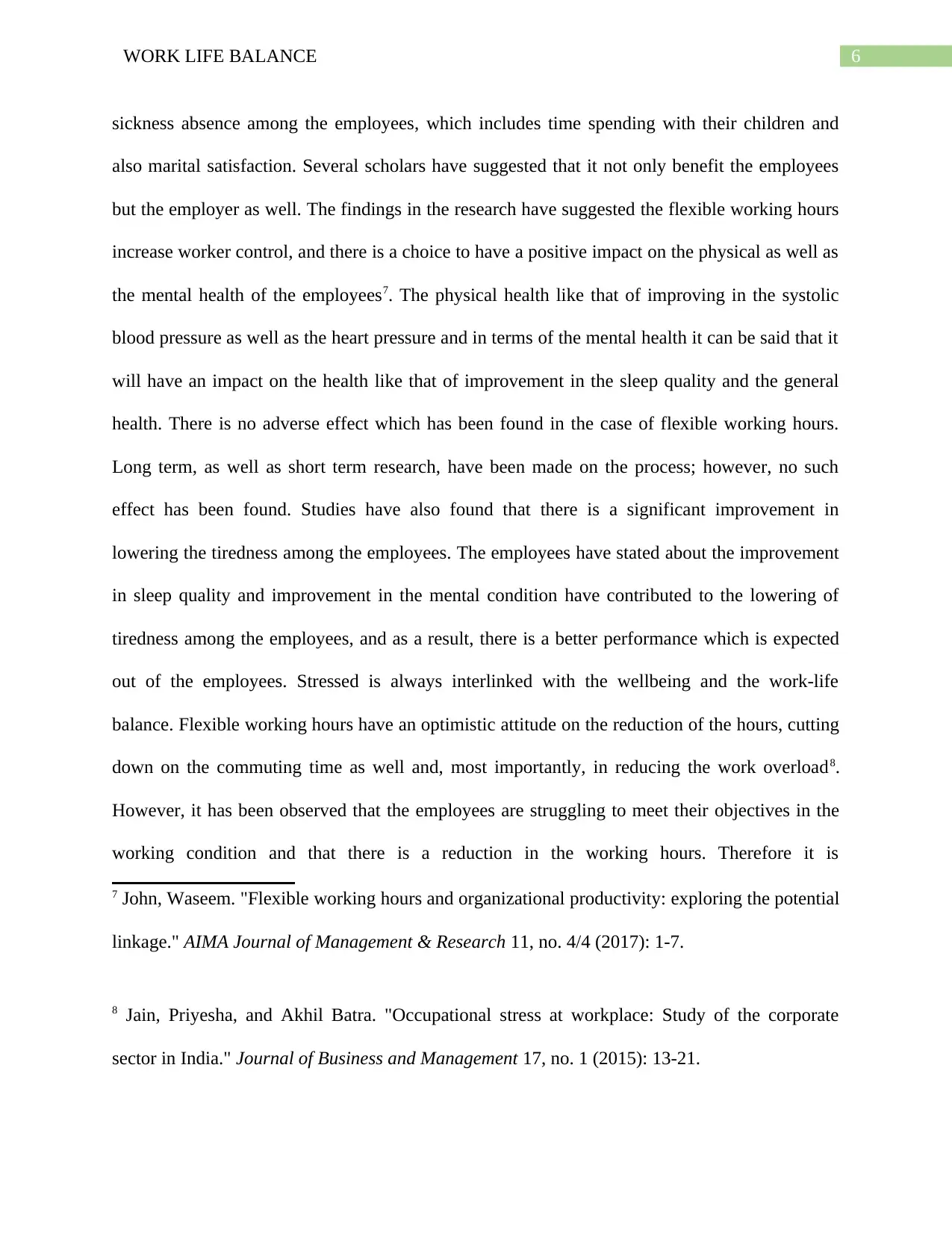
6WORK LIFE BALANCE
sickness absence among the employees, which includes time spending with their children and
also marital satisfaction. Several scholars have suggested that it not only benefit the employees
but the employer as well. The findings in the research have suggested the flexible working hours
increase worker control, and there is a choice to have a positive impact on the physical as well as
the mental health of the employees7. The physical health like that of improving in the systolic
blood pressure as well as the heart pressure and in terms of the mental health it can be said that it
will have an impact on the health like that of improvement in the sleep quality and the general
health. There is no adverse effect which has been found in the case of flexible working hours.
Long term, as well as short term research, have been made on the process; however, no such
effect has been found. Studies have also found that there is a significant improvement in
lowering the tiredness among the employees. The employees have stated about the improvement
in sleep quality and improvement in the mental condition have contributed to the lowering of
tiredness among the employees, and as a result, there is a better performance which is expected
out of the employees. Stressed is always interlinked with the wellbeing and the work-life
balance. Flexible working hours have an optimistic attitude on the reduction of the hours, cutting
down on the commuting time as well and, most importantly, in reducing the work overload8.
However, it has been observed that the employees are struggling to meet their objectives in the
working condition and that there is a reduction in the working hours. Therefore it is
7 John, Waseem. "Flexible working hours and organizational productivity: exploring the potential
linkage." AIMA Journal of Management & Research 11, no. 4/4 (2017): 1-7.
8 Jain, Priyesha, and Akhil Batra. "Occupational stress at workplace: Study of the corporate
sector in India." Journal of Business and Management 17, no. 1 (2015): 13-21.
sickness absence among the employees, which includes time spending with their children and
also marital satisfaction. Several scholars have suggested that it not only benefit the employees
but the employer as well. The findings in the research have suggested the flexible working hours
increase worker control, and there is a choice to have a positive impact on the physical as well as
the mental health of the employees7. The physical health like that of improving in the systolic
blood pressure as well as the heart pressure and in terms of the mental health it can be said that it
will have an impact on the health like that of improvement in the sleep quality and the general
health. There is no adverse effect which has been found in the case of flexible working hours.
Long term, as well as short term research, have been made on the process; however, no such
effect has been found. Studies have also found that there is a significant improvement in
lowering the tiredness among the employees. The employees have stated about the improvement
in sleep quality and improvement in the mental condition have contributed to the lowering of
tiredness among the employees, and as a result, there is a better performance which is expected
out of the employees. Stressed is always interlinked with the wellbeing and the work-life
balance. Flexible working hours have an optimistic attitude on the reduction of the hours, cutting
down on the commuting time as well and, most importantly, in reducing the work overload8.
However, it has been observed that the employees are struggling to meet their objectives in the
working condition and that there is a reduction in the working hours. Therefore it is
7 John, Waseem. "Flexible working hours and organizational productivity: exploring the potential
linkage." AIMA Journal of Management & Research 11, no. 4/4 (2017): 1-7.
8 Jain, Priyesha, and Akhil Batra. "Occupational stress at workplace: Study of the corporate
sector in India." Journal of Business and Management 17, no. 1 (2015): 13-21.
Paraphrase This Document
Need a fresh take? Get an instant paraphrase of this document with our AI Paraphraser
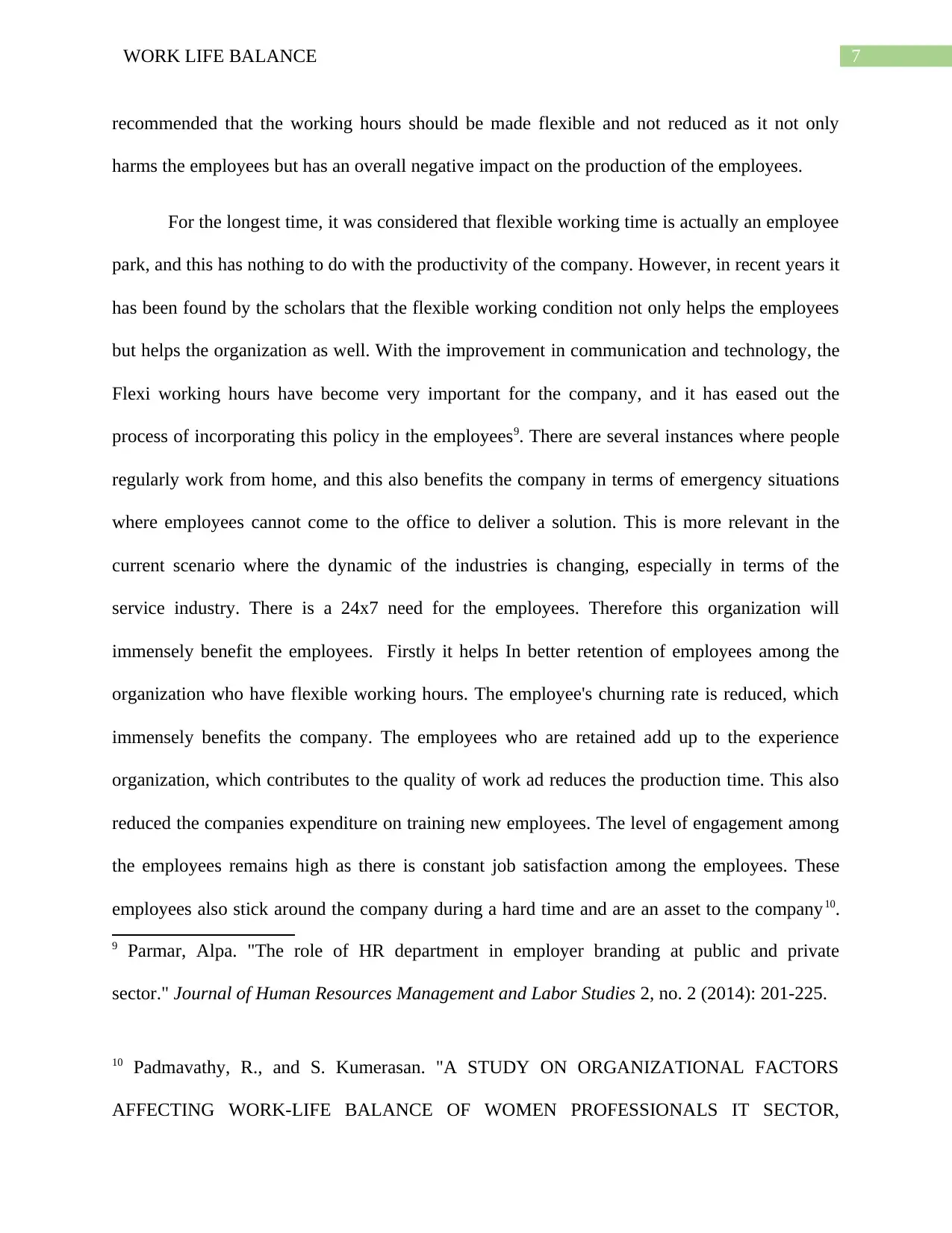
7WORK LIFE BALANCE
recommended that the working hours should be made flexible and not reduced as it not only
harms the employees but has an overall negative impact on the production of the employees.
For the longest time, it was considered that flexible working time is actually an employee
park, and this has nothing to do with the productivity of the company. However, in recent years it
has been found by the scholars that the flexible working condition not only helps the employees
but helps the organization as well. With the improvement in communication and technology, the
Flexi working hours have become very important for the company, and it has eased out the
process of incorporating this policy in the employees9. There are several instances where people
regularly work from home, and this also benefits the company in terms of emergency situations
where employees cannot come to the office to deliver a solution. This is more relevant in the
current scenario where the dynamic of the industries is changing, especially in terms of the
service industry. There is a 24x7 need for the employees. Therefore this organization will
immensely benefit the employees. Firstly it helps In better retention of employees among the
organization who have flexible working hours. The employee's churning rate is reduced, which
immensely benefits the company. The employees who are retained add up to the experience
organization, which contributes to the quality of work ad reduces the production time. This also
reduced the companies expenditure on training new employees. The level of engagement among
the employees remains high as there is constant job satisfaction among the employees. These
employees also stick around the company during a hard time and are an asset to the company10.
9 Parmar, Alpa. "The role of HR department in employer branding at public and private
sector." Journal of Human Resources Management and Labor Studies 2, no. 2 (2014): 201-225.
10 Padmavathy, R., and S. Kumerasan. "A STUDY ON ORGANIZATIONAL FACTORS
AFFECTING WORK-LIFE BALANCE OF WOMEN PROFESSIONALS IT SECTOR,
recommended that the working hours should be made flexible and not reduced as it not only
harms the employees but has an overall negative impact on the production of the employees.
For the longest time, it was considered that flexible working time is actually an employee
park, and this has nothing to do with the productivity of the company. However, in recent years it
has been found by the scholars that the flexible working condition not only helps the employees
but helps the organization as well. With the improvement in communication and technology, the
Flexi working hours have become very important for the company, and it has eased out the
process of incorporating this policy in the employees9. There are several instances where people
regularly work from home, and this also benefits the company in terms of emergency situations
where employees cannot come to the office to deliver a solution. This is more relevant in the
current scenario where the dynamic of the industries is changing, especially in terms of the
service industry. There is a 24x7 need for the employees. Therefore this organization will
immensely benefit the employees. Firstly it helps In better retention of employees among the
organization who have flexible working hours. The employee's churning rate is reduced, which
immensely benefits the company. The employees who are retained add up to the experience
organization, which contributes to the quality of work ad reduces the production time. This also
reduced the companies expenditure on training new employees. The level of engagement among
the employees remains high as there is constant job satisfaction among the employees. These
employees also stick around the company during a hard time and are an asset to the company10.
9 Parmar, Alpa. "The role of HR department in employer branding at public and private
sector." Journal of Human Resources Management and Labor Studies 2, no. 2 (2014): 201-225.
10 Padmavathy, R., and S. Kumerasan. "A STUDY ON ORGANIZATIONAL FACTORS
AFFECTING WORK-LIFE BALANCE OF WOMEN PROFESSIONALS IT SECTOR,
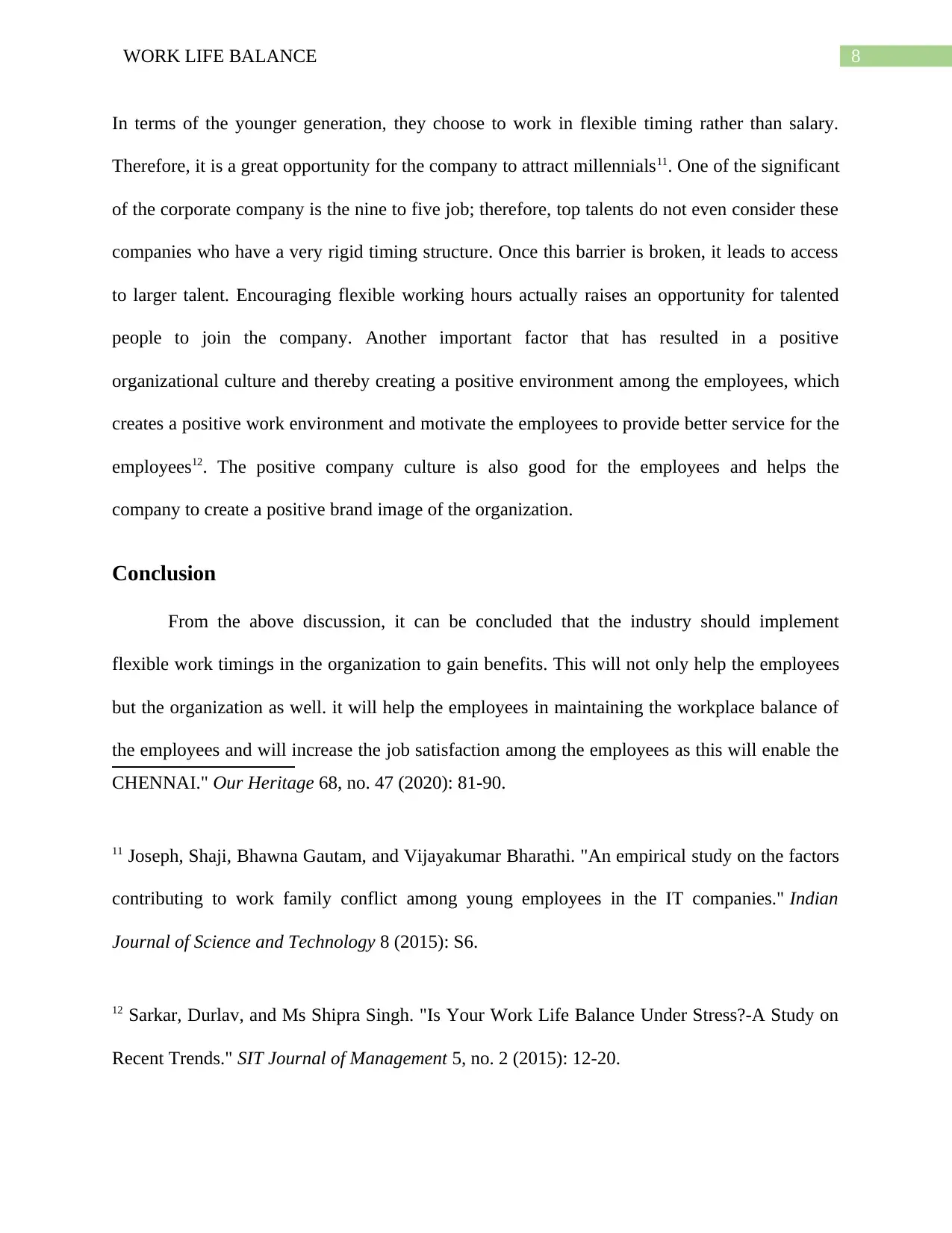
8WORK LIFE BALANCE
In terms of the younger generation, they choose to work in flexible timing rather than salary.
Therefore, it is a great opportunity for the company to attract millennials11. One of the significant
of the corporate company is the nine to five job; therefore, top talents do not even consider these
companies who have a very rigid timing structure. Once this barrier is broken, it leads to access
to larger talent. Encouraging flexible working hours actually raises an opportunity for talented
people to join the company. Another important factor that has resulted in a positive
organizational culture and thereby creating a positive environment among the employees, which
creates a positive work environment and motivate the employees to provide better service for the
employees12. The positive company culture is also good for the employees and helps the
company to create a positive brand image of the organization.
Conclusion
From the above discussion, it can be concluded that the industry should implement
flexible work timings in the organization to gain benefits. This will not only help the employees
but the organization as well. it will help the employees in maintaining the workplace balance of
the employees and will increase the job satisfaction among the employees as this will enable the
CHENNAI." Our Heritage 68, no. 47 (2020): 81-90.
11 Joseph, Shaji, Bhawna Gautam, and Vijayakumar Bharathi. "An empirical study on the factors
contributing to work family conflict among young employees in the IT companies." Indian
Journal of Science and Technology 8 (2015): S6.
12 Sarkar, Durlav, and Ms Shipra Singh. "Is Your Work Life Balance Under Stress?-A Study on
Recent Trends." SIT Journal of Management 5, no. 2 (2015): 12-20.
In terms of the younger generation, they choose to work in flexible timing rather than salary.
Therefore, it is a great opportunity for the company to attract millennials11. One of the significant
of the corporate company is the nine to five job; therefore, top talents do not even consider these
companies who have a very rigid timing structure. Once this barrier is broken, it leads to access
to larger talent. Encouraging flexible working hours actually raises an opportunity for talented
people to join the company. Another important factor that has resulted in a positive
organizational culture and thereby creating a positive environment among the employees, which
creates a positive work environment and motivate the employees to provide better service for the
employees12. The positive company culture is also good for the employees and helps the
company to create a positive brand image of the organization.
Conclusion
From the above discussion, it can be concluded that the industry should implement
flexible work timings in the organization to gain benefits. This will not only help the employees
but the organization as well. it will help the employees in maintaining the workplace balance of
the employees and will increase the job satisfaction among the employees as this will enable the
CHENNAI." Our Heritage 68, no. 47 (2020): 81-90.
11 Joseph, Shaji, Bhawna Gautam, and Vijayakumar Bharathi. "An empirical study on the factors
contributing to work family conflict among young employees in the IT companies." Indian
Journal of Science and Technology 8 (2015): S6.
12 Sarkar, Durlav, and Ms Shipra Singh. "Is Your Work Life Balance Under Stress?-A Study on
Recent Trends." SIT Journal of Management 5, no. 2 (2015): 12-20.
⊘ This is a preview!⊘
Do you want full access?
Subscribe today to unlock all pages.

Trusted by 1+ million students worldwide
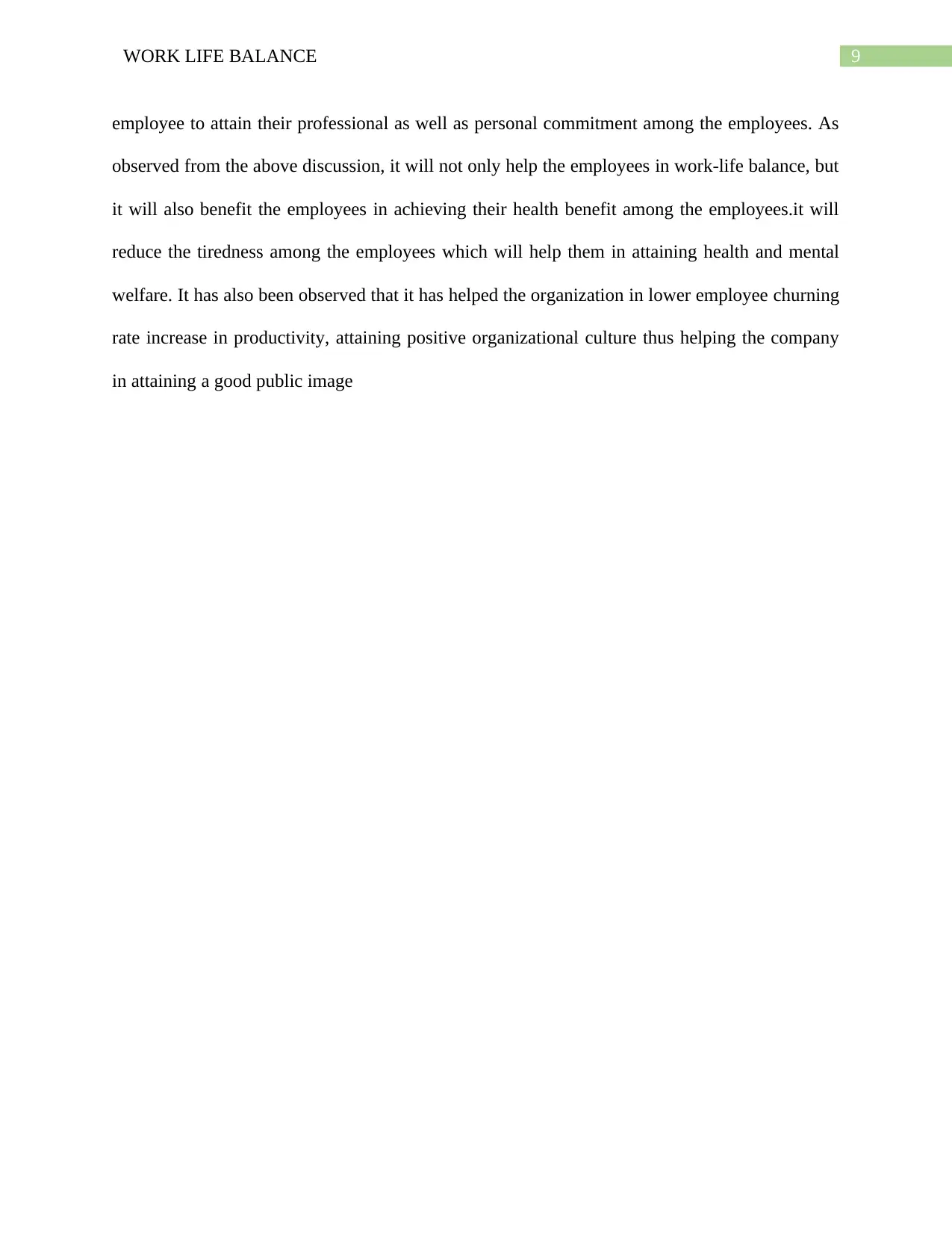
9WORK LIFE BALANCE
employee to attain their professional as well as personal commitment among the employees. As
observed from the above discussion, it will not only help the employees in work-life balance, but
it will also benefit the employees in achieving their health benefit among the employees.it will
reduce the tiredness among the employees which will help them in attaining health and mental
welfare. It has also been observed that it has helped the organization in lower employee churning
rate increase in productivity, attaining positive organizational culture thus helping the company
in attaining a good public image
employee to attain their professional as well as personal commitment among the employees. As
observed from the above discussion, it will not only help the employees in work-life balance, but
it will also benefit the employees in achieving their health benefit among the employees.it will
reduce the tiredness among the employees which will help them in attaining health and mental
welfare. It has also been observed that it has helped the organization in lower employee churning
rate increase in productivity, attaining positive organizational culture thus helping the company
in attaining a good public image
Paraphrase This Document
Need a fresh take? Get an instant paraphrase of this document with our AI Paraphraser
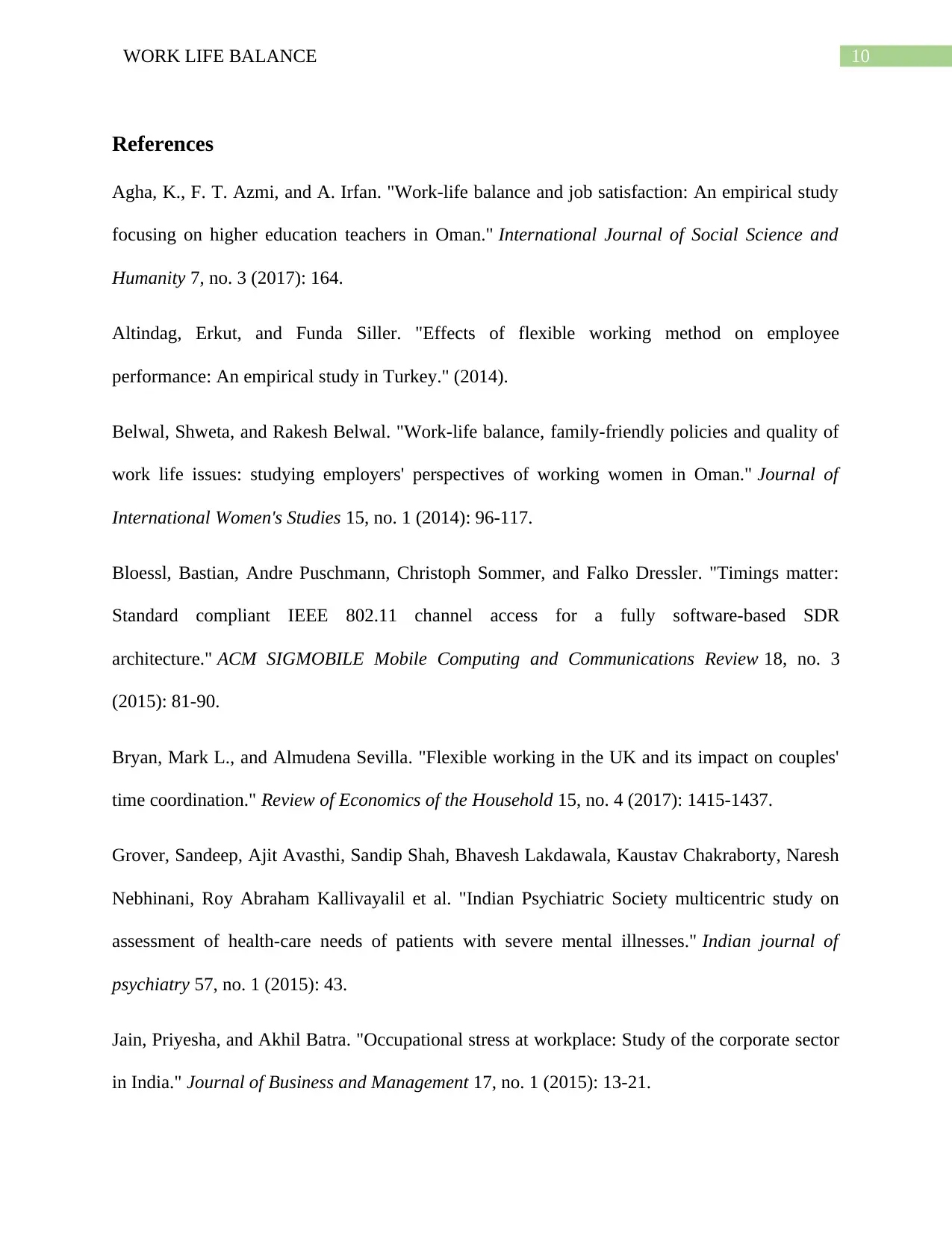
10WORK LIFE BALANCE
References
Agha, K., F. T. Azmi, and A. Irfan. "Work-life balance and job satisfaction: An empirical study
focusing on higher education teachers in Oman." International Journal of Social Science and
Humanity 7, no. 3 (2017): 164.
Altindag, Erkut, and Funda Siller. "Effects of flexible working method on employee
performance: An empirical study in Turkey." (2014).
Belwal, Shweta, and Rakesh Belwal. "Work-life balance, family-friendly policies and quality of
work life issues: studying employers' perspectives of working women in Oman." Journal of
International Women's Studies 15, no. 1 (2014): 96-117.
Bloessl, Bastian, Andre Puschmann, Christoph Sommer, and Falko Dressler. "Timings matter:
Standard compliant IEEE 802.11 channel access for a fully software-based SDR
architecture." ACM SIGMOBILE Mobile Computing and Communications Review 18, no. 3
(2015): 81-90.
Bryan, Mark L., and Almudena Sevilla. "Flexible working in the UK and its impact on couples'
time coordination." Review of Economics of the Household 15, no. 4 (2017): 1415-1437.
Grover, Sandeep, Ajit Avasthi, Sandip Shah, Bhavesh Lakdawala, Kaustav Chakraborty, Naresh
Nebhinani, Roy Abraham Kallivayalil et al. "Indian Psychiatric Society multicentric study on
assessment of health-care needs of patients with severe mental illnesses." Indian journal of
psychiatry 57, no. 1 (2015): 43.
Jain, Priyesha, and Akhil Batra. "Occupational stress at workplace: Study of the corporate sector
in India." Journal of Business and Management 17, no. 1 (2015): 13-21.
References
Agha, K., F. T. Azmi, and A. Irfan. "Work-life balance and job satisfaction: An empirical study
focusing on higher education teachers in Oman." International Journal of Social Science and
Humanity 7, no. 3 (2017): 164.
Altindag, Erkut, and Funda Siller. "Effects of flexible working method on employee
performance: An empirical study in Turkey." (2014).
Belwal, Shweta, and Rakesh Belwal. "Work-life balance, family-friendly policies and quality of
work life issues: studying employers' perspectives of working women in Oman." Journal of
International Women's Studies 15, no. 1 (2014): 96-117.
Bloessl, Bastian, Andre Puschmann, Christoph Sommer, and Falko Dressler. "Timings matter:
Standard compliant IEEE 802.11 channel access for a fully software-based SDR
architecture." ACM SIGMOBILE Mobile Computing and Communications Review 18, no. 3
(2015): 81-90.
Bryan, Mark L., and Almudena Sevilla. "Flexible working in the UK and its impact on couples'
time coordination." Review of Economics of the Household 15, no. 4 (2017): 1415-1437.
Grover, Sandeep, Ajit Avasthi, Sandip Shah, Bhavesh Lakdawala, Kaustav Chakraborty, Naresh
Nebhinani, Roy Abraham Kallivayalil et al. "Indian Psychiatric Society multicentric study on
assessment of health-care needs of patients with severe mental illnesses." Indian journal of
psychiatry 57, no. 1 (2015): 43.
Jain, Priyesha, and Akhil Batra. "Occupational stress at workplace: Study of the corporate sector
in India." Journal of Business and Management 17, no. 1 (2015): 13-21.
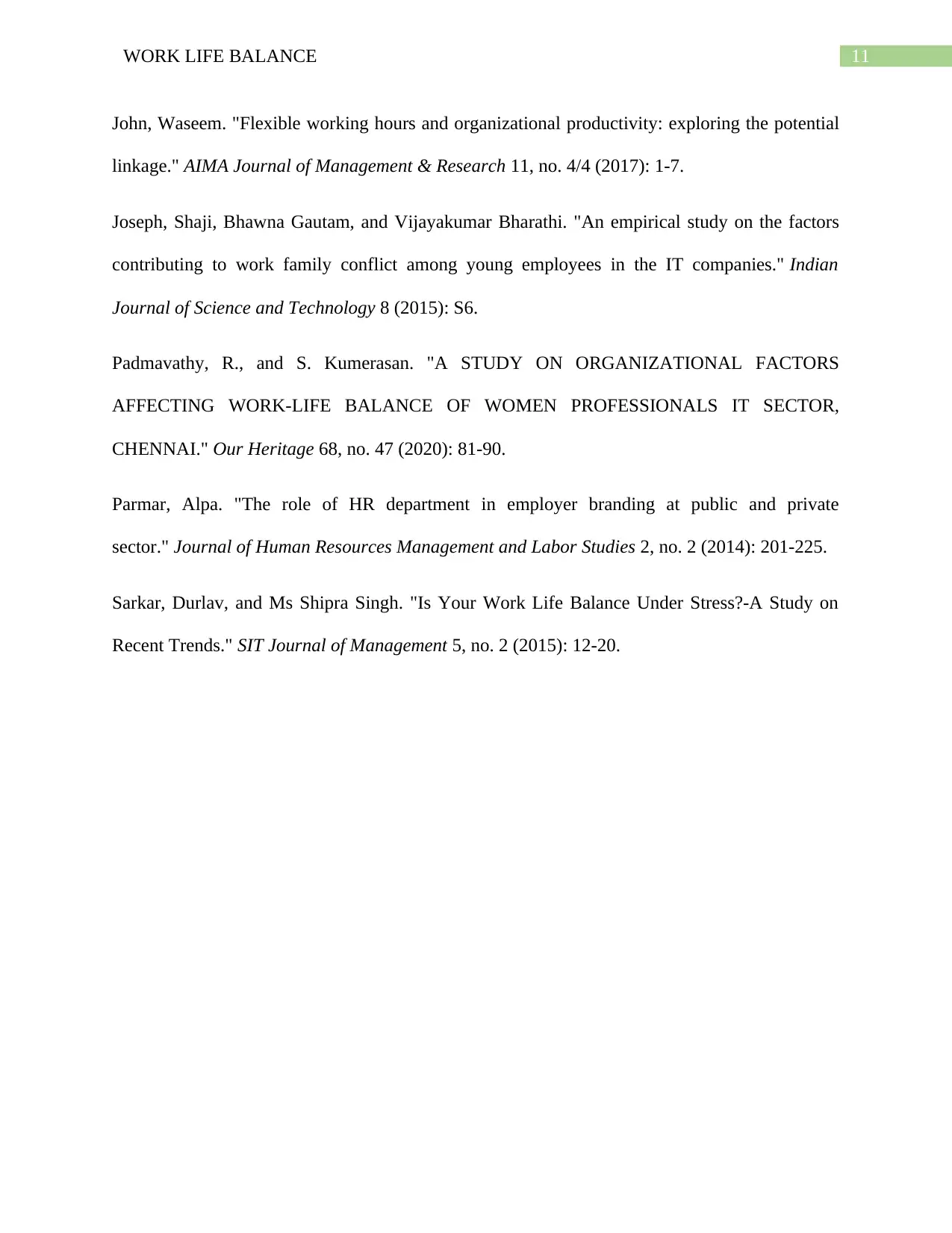
11WORK LIFE BALANCE
John, Waseem. "Flexible working hours and organizational productivity: exploring the potential
linkage." AIMA Journal of Management & Research 11, no. 4/4 (2017): 1-7.
Joseph, Shaji, Bhawna Gautam, and Vijayakumar Bharathi. "An empirical study on the factors
contributing to work family conflict among young employees in the IT companies." Indian
Journal of Science and Technology 8 (2015): S6.
Padmavathy, R., and S. Kumerasan. "A STUDY ON ORGANIZATIONAL FACTORS
AFFECTING WORK-LIFE BALANCE OF WOMEN PROFESSIONALS IT SECTOR,
CHENNAI." Our Heritage 68, no. 47 (2020): 81-90.
Parmar, Alpa. "The role of HR department in employer branding at public and private
sector." Journal of Human Resources Management and Labor Studies 2, no. 2 (2014): 201-225.
Sarkar, Durlav, and Ms Shipra Singh. "Is Your Work Life Balance Under Stress?-A Study on
Recent Trends." SIT Journal of Management 5, no. 2 (2015): 12-20.
John, Waseem. "Flexible working hours and organizational productivity: exploring the potential
linkage." AIMA Journal of Management & Research 11, no. 4/4 (2017): 1-7.
Joseph, Shaji, Bhawna Gautam, and Vijayakumar Bharathi. "An empirical study on the factors
contributing to work family conflict among young employees in the IT companies." Indian
Journal of Science and Technology 8 (2015): S6.
Padmavathy, R., and S. Kumerasan. "A STUDY ON ORGANIZATIONAL FACTORS
AFFECTING WORK-LIFE BALANCE OF WOMEN PROFESSIONALS IT SECTOR,
CHENNAI." Our Heritage 68, no. 47 (2020): 81-90.
Parmar, Alpa. "The role of HR department in employer branding at public and private
sector." Journal of Human Resources Management and Labor Studies 2, no. 2 (2014): 201-225.
Sarkar, Durlav, and Ms Shipra Singh. "Is Your Work Life Balance Under Stress?-A Study on
Recent Trends." SIT Journal of Management 5, no. 2 (2015): 12-20.
⊘ This is a preview!⊘
Do you want full access?
Subscribe today to unlock all pages.

Trusted by 1+ million students worldwide
1 out of 12
Related Documents
Your All-in-One AI-Powered Toolkit for Academic Success.
+13062052269
info@desklib.com
Available 24*7 on WhatsApp / Email
![[object Object]](/_next/static/media/star-bottom.7253800d.svg)
Unlock your academic potential
Copyright © 2020–2025 A2Z Services. All Rights Reserved. Developed and managed by ZUCOL.





